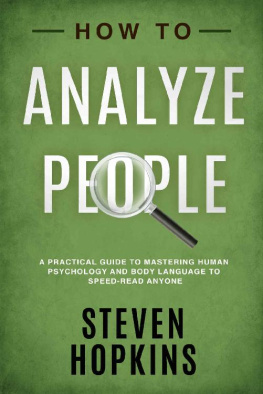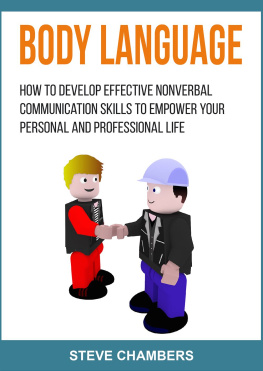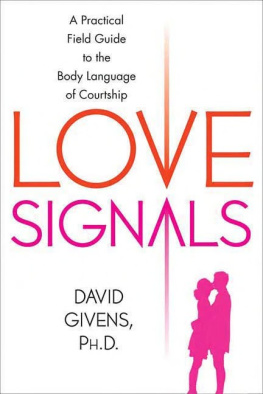
Portfolio / Penguin
An imprint of Penguin Random House LLC
penguinrandomhouse.com

Copyright 2022 by Vanessa Van Edwards
Penguin supports copyright. Copyright fuels creativity, encourages diverse voices, promotes free speech, and creates a vibrant culture. Thank you for buying an authorized edition of this book and for complying with copyright laws by not reproducing, scanning, or distributing any part of it in any form without permission. You are supporting writers and allowing Penguin to continue to publish books for every reader.
Image credits: by Vanessa Van Edwards.
Library of Congress Cataloging-in-Publication Data
Names: Edwards, Vanessa Van, author.
Title: Cues: master the secret language of charismatic communication / Vanessa Van Edwards.
Description: New York: Portfolio, [2022] | Includes bibliographical references and index.
Identifiers: LCCN 2021048764 (print) | LCCN 2021048765 (ebook) | ISBN 9780593332191 (hardcover) | ISBN 9780593332207 (ebook)
Subjects: LCSH: Interpersonal communication. | Social interaction. | Body language.
Classification: LCC BF637.C45 E32 2022 (print) | LCC BF637.C45 (ebook) | DDC 153.6dc23/eng/20211202
LC record available at https://lccn.loc.gov/2021048764
LC ebook record available at https://lccn.loc.gov/2021048765
Cover design: Elizabeth Connor
Book design by Tanya Maiboroda, adapted for ebook by Cora Wigen
While the author has made every effort to provide accurate internet addresses at the time of publication, neither the publisher nor the author assumes any responsibility for errors or for changes that occur after publication. Further, the publisher does not have any control over and does not assume any responsibility for author or third-party websites or their content.
pid_prh_6.0_139326548_c0_r0
To my husband, Scott, and my daughter, Sienna.
I love your cues.
Cues
noun, plural
the powerful verbal, nonverbal, and vocal signals humans send to one another.
Contents
INTRODUCTION
The Signals That Are Secretly Shaping You
Have you ever shared a great idea only to find that others didnt get it?
Youre not alone.
This was exactly what happened to mogul and entrepreneur Jamie Siminoff, the founder of Ring. His video doorbell company made headlines when it was acquired by Amazon in 2018 for over $1 billion. But before Ring was installed on millions of front doors around the world, it was almost derailed by a single bad pitch on Shark Tank, a TV show where entrepreneurs talk up their company to a panel of investors.
In fact, when Jamie went on the show in 2013 to pitch his company (then called Doorbot), every single Shark passed on the opportunity to investdespite strong early sales and traction.
What happened?
The answer lies not in the information Siminoff presented but in how he presented it. Virtually every tiny signal, or cue, Siminoff sharedthrough his body language, vocal modulation, and pitchundermined his credibility. He all but told the Sharks to stay away.
Siminoff had a great idea with huge potential, but with the wrong cues, it crashed and burned. Those cues spoke even louder than his billion-dollar idea.
Lets go through Siminoffs pitch step by step so you can see exactly where his cues went wrong.
Siminoff began his pitch with a knock on the door to the Shark Tank. Whos there? tech investor and Shark Mark Cuban asked. Siminoff replied from behind the closed door: Its Jamie?
This was Siminoffs first cue, or miscue. Instead of stating his name, he asked it. This is an example of a question inflection, also known as uptalk. Research has found that when the question inflection is accidentally used in a statement, it signals low confidence and insecurity. When the question inflection is used with a statement, it causes the listeners brain to question the speakers credibility. The brain says, If you arent confident in what you just said, why should I be?
Making things worse, Siminoff used the question inflection a second time: Here to pitch? Repeating this cue reinforced his lack of confidenceand he hadnt even started the pitch yet! Not a great first impression.
When the door finally opened, Canadian entrepreneur Robert Herjavec gave Siminoff a cue of his own: a fake smile. A genuine smile reaches all the way to the upper cheeks, activating the crows-feet on the sides of your eyes. A fake smile appears only on the bottom half of the face. Herjavecs fake smile should have signaled Siminoff to change tack. If hed caught it, he could have worked to build rapport with Herjavec. He didnt, and Herjavec passed on the idea.
When Siminoff finally began his official pitch, things seemingly moved back in his favor. He fielded questions from the Sharks on everything from market size to pricing. Mark Cuban even gave him a Good for you! when Siminoff shared that hed had over a million dollars in sales. Throughout, however, the cues passing back and forth told a very different story about Siminoffs chances.
Three minutes in, Cuban pulled the corners of his mouth down into what looks like a frown but is actually a mouth shrug. This cue signals disbelief or doubt. Its a sign that someone feels disconnected or indifferent.
Researchers believe this is because the position of the mouth makes it impossible to speak. Its a nonverbal way of indicating a lack of interest in responding and therefore a bid to terminate the exchange of information. Cuban was telling Siminoff, Im done here.
Shark Tank
Instead of seizing that moment to address Cubans disbelief, Siminoff barreled along obliviously. If hed registered Cubans cue, he could have addressed his doubt with a simple acknowledgment: Mark, I see that youre skeptical. Let me share some data with you. But Siminoff could only hear the wordsGood for you!and missed the underlying nonverbal message. A few minutes later, Cuban pulled out of the deal.
Of course, Siminoff wasnt just blind to the Sharks negative cues during his pitch. He was also sending dozens of his own. For example, when he mentioned the price of his product, he showed a one-sided shoulder shrug, yet another low-confidence signal. Five minutes in, challenged on a crucial point about the future of smart devices, Siminoff gulped a deep swallow, a cue conveying nervousness. While all of this is completely understandablewho wouldnt be anxious defending years of work in front of skeptical billionaires on a TV showthese cues completely undermined the clear and confident words he actually spoke. A strong idea cannot stand alone. It needs to be accompanied by strong cues.
Siminoff slipped yet again when he tried to convince the Sharks he didnt face any serious competition in the space. His answer started strong, but then he leaked a halt cue: We do not have any direct competitors. When I say direct [pause], were [pause] the first video doorbell built for the smartphone. As you can see, a halt cue is when someone adds an out-of-place pause in the middle of a sentence. Liars halt. So do the very nervous. Since our brains cant tell the difference, we protectively and instinctively worry that someone is being dishonest. Halting can also occur when someone switches from a spontaneous answer to a rehearsed one. This is probably what happened to Siminoff. Having realized mid-sentence that hed prepped for this question, he switched over to his script. Even though the substance of what he was saying was faultless, the choppy delivery undermined his credibility yet again.















